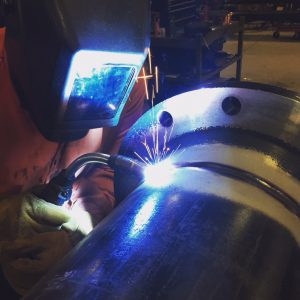Many fabricators struggle to get a grip on their welding costs. The best they can do is try to find suppliers that will sell them their consumables, gas and other raw materials at a lower price. Those who try to reduce costs by being more efficient soon realize that simply speeding up welding is not sufficient to significantly reduce costs.
The reason speeding up welding is not sufficient is because most of the time your welders are not welding. An average welder will have an operator factor of about 12-15%. That is, they weld about 7 to 9 minutes out of every hour. What??? That’s insane! So, what are they doing the rest of the time?
Well, definitely not taking breaks. There is so much involved in fabrication that welders end up doing a lot of work that has nothing to do with welding. All these activities are part of what makes up the entire cost of fabrication. So what are these activities?
The list below includes activities that are necessary and must be accounted for when calculating costs.
- Preparing the weld joint – this can include putting a bevel on a plate or simply cleaning the joint to free it of mill scale, rust, oil or other contaminants.
- Assembly – this is bringing all the pieces together into a fixture or simply bringing them to a weld station where the welder can easily grab all the necessary components.
- Tacking
- Positioning – in a perfect world we weld everything in the flat position, or horizontal for fillet welds. In some cases, we cannot position the part, but when we can we’ll move it in order to weld easier.
- Welding
- Changing filler metal and/or shielding gas – spools of wire, stick electrodes and bottles of shielding gas don’t last forever. We need to account for this changeover time.
- Breaks – most shops allow for breaks. This can be as little as a 10-minute break in the morning and another 10-minute break in the afternoon. This can also include time for production and safety meetings.
- Cleaning – cleaning performed at the end of the day, between shifts or even between assembly of each product.
- Moving the assembly once completed – once the assembly is fully welded it needs to be moved elsewhere.
- Time for postweld heat treatment – if necessary, the time for postweld heat treatment must be accounted for.
As you can see there are a lot of necessary non-welding activities. Some of these cannot be eliminated. Tacking may be eliminated with elaborate fixtures and changing shielding gas bottle changeover may be eliminated by using a bulk gas delivery system, but in general, all these activities are here to stay.
So how can we reduce non-welding time?
The list above are necessary activities. But when we do walk-throughs in fabricating shops we typically find a lot of non-value added activities which can be reduced or eliminated. Here are some of these activities. See if you have any of these in your shop.
- Changing contact tips excessively – contact tip usage can be reduced by improving the arc via better welding procedures, better ground connection, better part fit up and better joint preparation amongst other things.
- Cleaning spatter – spatter can be reduced or eliminated. Time spent grinding is very costly. If you want ideas on how to get rid of spatter read: 7 Causes of Spatter and How to Eliminate It.
- Repairs – repairs may be due to welder performance, bad fit up, bad welding procedures and many other things. Reducing repairs can significantly reduce costs.
- Waiting on parts – When a welder is waiting for parts there is very little he or she can do to stay productive. Ensuring proper material flow in the shop is essential.
- Waiting for cranes or other material handling equipment – cranes and forklifts are used to bring parts to stations, but sometimes they are used to change the position of parts during the welding process. When cranes are not available the welder will just sit and wait.
- Equipment downtime – welding equipment in disrepair can decrease productivity significantly. A wire feeder that constantly bird nests can take up to an hour or more of your welder’s time in one day. On an eight-hour shift that is 12.5% of the day. A preventive maintenance program can yield substantial savings.
There are many other non-value added activities, but start looking for the ones above in your shop. You’ll be surprise how much non-welding time can be reduced simply by taking care of essential things.
Reference: The Procedure Handbook For Arc Welding, 14th Edition


Please note: I reserve the right to delete comments that are offensive or off-topic.